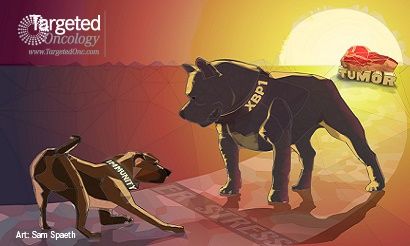Ovarian Cancer Immune Response May Be Restored by Fighting XBP1
A team at Weill Cornell Medical College in New York that is studying ovarian cancer has not only discovered another mechanism by which tumors evade attack by the immune system, but is also devising a first-in-class potential treatment.
Laurie H. Glimcher, MD

Laurie H. Glimcher, MD
A team at Weill Cornell Medical College in New York that is studying ovarian cancer has not only discovered another mechanism by which tumors evade attack by the immune system, but is also devising a first-in-class potential treatment.1,2The results are published in the June 18 issue ofCell.
“Harnessing the natural ability of our immune system to eliminate malignant cells represents the most promising anti-ovarian cancer strategy since the development of chemotherapy,” said senior author Laurie H. Glimcher, MD, the Stephen and Suzanne Weis Dean of Weill Cornell Medical College and a researcher in its Sandra and Edward Meyer Cancer Center, in a press release. She and her colleagues are developing new ways to unleash protective immune responses in ovarian cancer.2
Earlier Work
3
In a paper published inNaturein 2014, Glimcher et al found that a transcription factor calledXBP1, present in the endoplasmic reticulum (ER) of cells, was activated in triple-negative breast cancer (TNBC) and played an important role in tumorigenicity and progression of disease.3The gene forXBP1is a component of the ER stress response pathway (also called the unfolded protein response) and is permissive of tumor growth and survival when nutrients and oxygen levels are low.2,4Using cell lines, they showed that depletingXBP1inhibited tumor growth and relapse. When they analyzed groups of patients with TNBC they found a specificXBP1gene expression signature that was highly correlated with hypoxic conditions (eg, hypoxia-inducible factor 1-α [HIF-1α], hypoxia driven signatures), which is strongly associated with poor prognosis.The results showed thatXBP1could promote tumor cell survival; then the team tackled the question of whetherXBP1somehow also enabled tumor cells to evade attack by the immune system.
DESCRIPTION

Latest Studies
2
To answer this question and develop a possible new treatment, the researchers turned their attention to ovarian cancer. “The high death rate in ovarian cancer has remained the same over the last 40 years because there have been no new therapeutic strategies,” said Glimcher.
1
Analysis of human specimens and samples from preclinical models of ovarian cancer revealed a microenvironment with high concentrations of toxic reactive oxygen species (ROS).2Glimcher et al demonstrated that ROS led to the accumulation of byproducts of lipid peroxidation within tumor dendritic cells.This promoted ER stress and led to the activation ofXBP1. Herber et al5had previously shown that dendritic cells in tumors contain high amounts of triglycerides,5and Glimcher’s team confirmed that ovarian tumor dendritic cells exhibited upregulation of multipleXBP1-controlled genes responsible for triglyceride biosynthesis.1Dendritic cells containing high levels of lipids have been reported to have impaired antigen-presenting capabilities, leaving them unable to stimulate T cells to mount an immune response against tumor cells, but a mechanism for this defect was not described.5
2
“While that kept dendritic cells healthy,XBP1also switched on genes that block their ability to stimulate other immune cells,” said lead coauthor Juan R. Cubillos-Ruiz, PhD, an instructor of immunology in medicine at Weill Cornell, in the press release.Confirmation was obtained when they found that T cells taken from tumor-bearing mice, with dendritic cells that lackedXBP1were more effective at reducing tumor growth.1
A Novel Nanoparticle Therapy
These results inferred that if the expression ofXBP1in ovarian tumor-associated dendritic cells could be turned off, it would promote the efficacy of tumor-infiltrating antitumor T cells and lead to the induction of antitumor immunity. “We are now devising first-in-class drugs that can inhibit the activity ofXBP1in both cancer cells and dendritic cells, which would both sensitize the cancer to treatment and restore an immune response against it,” said Cubillos-Ruiz.2
1
They exposed ovarian tumor-associated dendritic cells to nanoparticles containingXBP1-specific short interfering RNA (siRNA), and achieved about 65% gene silencing compared with control. The nanoparticles also reduced triglyceride levels in tumor dendritic cells versus controls. When nanoparticles containing the gene silencer were injected into mice there was a reduction in the number of metastatic cells in the peritoneal cavity and an increase in the number of activated T cells present at tumor sites, compared with controls. Finally, when mice implanted with aggressive orthotopic ovarian tumors were treated intraperitoneally with the gene-silencing nanoparticles, there was a marked increase in survival compared with controls.“The nanoparticles act like a Trojan horse, releasing the payload that will turnXBP1off,” said Cubillos-Ruiz.2
6
Noting the success of other immune-based approaches in other lethal cancers such as melanoma,Glimcher said, “Our study shows thatXBP1activation in dendritic cells drives both primary and metastatic ovarian cancer progression. We believe that targetingXBP1should both inhibit tumor growth and enhance anticancer immunity.”2
References
- Cubillos-Ruiz JR, Silberman PC, Rutkowski MR, et al. ER stress sensor XBP1 controls anti-tumor immunity by disrupting dendritic cell homeostasis.Cell.http://dx.doi.org/10.1016/j.cell.2015.05.025. In press.
- Weill Cornell press release. weill-cornell-investigators-discover-how-ovarian-cancer-halts-bodys-natural-defense-against-tumor. Accessed June 10, 2015.
- Chen X, Iliopoulos D, Zhang Q, et al. XBP1 promotes triple-negative breast cancer by controlling the HIF1α pathway.Nature. 2014;508:103-107.
- Hetz C, Chevet E, Harding HP. Targeting the unfolded protein response in disease.Nat Rev Drug Discov. 2013;12:703-719.
- Herber DL, Cao W, Nefedova Y, et al. Lipid accumulation and dendritic cell dysfunction in cancer.Nat Med. 2010;16:880-886.